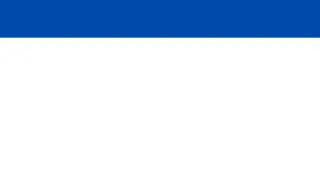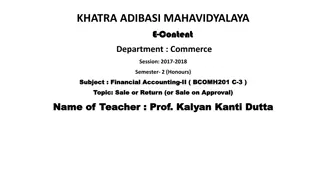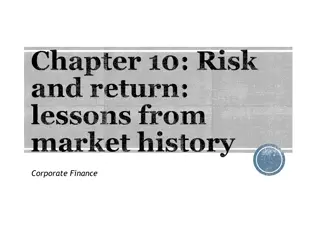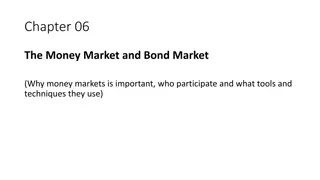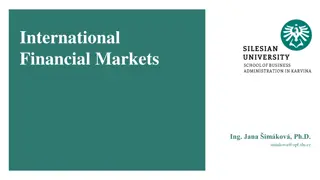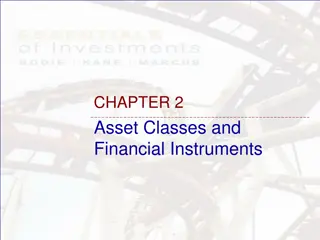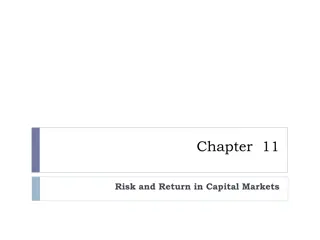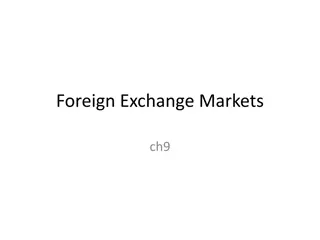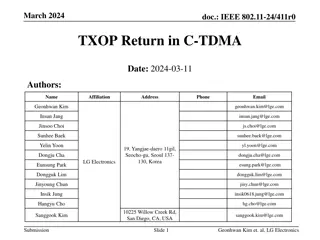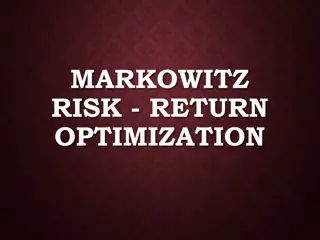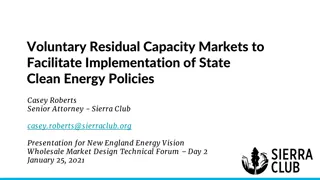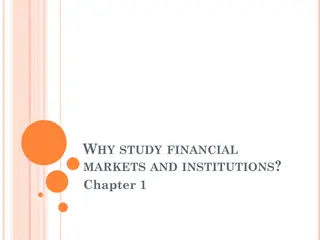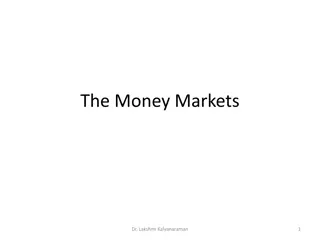Understanding Risk and Return in Financial Markets
This chapter delves into the concepts of risk and return in financial markets, exploring the relationship between expected and unexpected returns, systematic and unsystematic risk, and the Security Market Line. It also discusses the impact of announcements and news on stock returns, distinguishing between systematic and unsystematic components. Through examples and explanations, the chapter aims to provide a comprehensive understanding of how risk and return are interconnected in the world of finance.
Download Presentation

Please find below an Image/Link to download the presentation.
The content on the website is provided AS IS for your information and personal use only. It may not be sold, licensed, or shared on other websites without obtaining consent from the author. Download presentation by click this link. If you encounter any issues during the download, it is possible that the publisher has removed the file from their server.
E N D
Presentation Transcript
Chapter 12 Return, Risk, and the Security Market Line
Learning Objectives Our goal in this chapter is to define risk more precisely, and discuss how to measure it. In addition, we will quantify the relation between risk and return in financial markets. More specifically, our goal is to understand 1. The difference between expected and unexpected returns. 2. The difference between systematic risk and unsystematic risk. 3. The security market line and the capital asset pricing model. 4. The importance of beta. 2
Expected and Unexpected Returns The return on any stock traded in a financial market is composed of two parts. The normal, or expected, part of the return is the return that investors predict or expect. The uncertain, or risky, part of the return comes from unexpected information revealed during the year. Expected = Unexpected + Total Return Return Return Total = Unexpected Return Return Expected - Return E(R) - R = U 3
Announcements and News Firms make periodic announcements about events that may significantly impact the profits of the firm. Earnings Product development Personnel The impact of an announcement depends on how much of the announcement represents new information. When the situation is not as bad as previously thought, what seems to be bad news is actually good news. When the situation is not as good as previously thought, what seems to be good news is actually bad news. News about the future is what really matters. Market participants factor predictions about the future into the expected part of the stock return. Announcement = Expected News + Surprise News 4
Systematic and Unsystematic Risk Systematic risk is risk that influences a large number of assets. Also called market risk. Unsystematic risk is risk that influences a single company or a small group of companies. Also called unique riskor firm-specific risk. Total risk = Systematic risk + Unsystematic risk 5
Pop Quiz: Systematic Risk or Unsystematic Risk? The government announces that inflation unexpectedly jumped by 2 percent last month. Systematic Risk One of Big Widget s major suppliers goes bankruptcy. Unsystematic Risk The head of accounting department of Big Widget announces that the company s current ratio has been severely deteriorating. Unsystematic Risk Congress approves changes to the tax code that will increase the top marginal corporate tax rate. Systematic Risk 6
Systematic and Unsystematic Components of Return Recall: R E(R) = U = Systematic portion+ Unsystematic portion = m + R E(R) = m + 7
Diversification and Risk In a large portfolio: Some stocks will go up in value because of positive company- specific events, while Others will go down in value because of negative company- specific events. Unsystematic risk is essentially eliminated by diversification, so a portfolio with many assets has almost no unsystematic risk. Unsystematic risk is also called diversifiablerisk. Systematic risk is also called non-diversifiablerisk. 8
The Systematic Risk Principle What determines the size of the risk premium on a risky asset? The systematic risk principle states: The expected return on an asset depends only on its systematic risk. So, no matter how much total risk an asset has, only the systematic portion is relevant in determining the expected return (and the risk premium) on that asset. 9
Measuring Systematic Risk To be compensated for risk, the risk has to be special. Unsystematic risk is not special. Systematic risk is special. The Beta coefficient ( ) measures the relative systematic risk of an asset. Assets with Betas larger than 1.0 have more systematic risk than average. Assets with Betas smaller than 1.0 have less systematic risk than average. Because assets with larger betas have greater systematic risks, they will have greater expected returns. Note that not all Betas are created equally. 10
Betas with Respect to the S&P 500 for Individual Stocks (based on monthly data for 2004 2008) 11
Portfolio Betas The total risk of a portfolio has no simple relation to the total risk of the assets in the portfolio. Recall the variance of a portfolio equation For two assets, you need two variances and the covariance. For four assets, you need four variances, and six covariances. In contrast, a portfolio Beta can be calculated just like the expected return of a portfolio. That is, you can multiply each asset s Beta by its portfolio weight and then add the results to get the portfolio s Beta. 13
Example: Calculating a Portfolio Beta Using Value Line data from Table 12.1, we see Beta for Southwest Airlines (LUV) is 1.05 Beta for General Motors (GM) 1.45 You put half your money into LUV and half into GM. What is your portfolio Beta? = + .50 .50 p LUV GM .50 = + 1.05 .50 1.45 1.25 = 12-14
Capital Asset Pricing Model (CAPM) Now, we will go back to the Markowitz's efficient market frontier. In order to derive the CAPM, Capital Market Line (CML), Security Market Line (SML). Here, we will try to derive the security market line (SML), which is a linear line characterized with risk-free rate and the market portfolio. A series of graphs explain all . 15
Efficient Frontier with Ten Stocks Versus Three Stocks 16
Risk-Free Saving and Borrowing Risk can also be reduced by investing a portion of a portfolio in a risk-free investment, like T-Bills. However, doing so will likely reduce the expected return. On the other hand, an aggressive investor who is seeking high expected returns might decide to borrow money to invest even more in the stock market. 17
Investing in Risk-Free Securities Consider an arbitrary risky portfolio and the effect on risk and return of putting a fraction of the money in the portfolio, while leaving the remaining fraction in risk-free Treasury bills. The expected return would be: = = + + [ ] (1 ) x r [ ] E R xE R xP f P f r ( [ x E R ] ) f r P 18
Investing in Risk-Free Securities (cont'd) The standard deviation of the portfolio would be calculated as: = + + 2 2 [ ] (1 ) x Var r ( ) f ( ) 2(1 ) x xCov r R ( , ) SD R x Var R xP P f P = = 2 ( ) ) x Var R xSD R 0 P ( P Note: The standard deviation is only a fraction of the volatility of the risky portfolio, based on the amount invested in the risky portfolio. 19
The RiskReturn Combinations from Combining a Risk- Free Investment and a Risky Portfolio 20
The Market Portfolio Because portfolio M lies at the point of tangency, it has the highest portfolio possibility line So, everybody will want to invest in Portfolio M and borrow or lend to be somewhere on the straight line. This line is called the Capital Market Line (CML). Therefore this portfolio must include ALL RISKY ASSETS not only U.S. common stocks but also all risky assets, such as Non-U.S. stocks, options, real estate, coins, and art. 23
Continued Because the market is in equilibrium, all assets are included in this portfolio in proportion to their market value Because it contains all risky assets, it is a completely diversified portfolio, which means that all the unique risk of individual assets (unsystematic risk) is diversified away All portfolios on the CML are perfectly positively correlated with each other and with the completely diversified market Portfolio M A completely diversified portfolio would have a correlation with the market portfolio of +1.00 24
The CML and the Separation Theorem Investors preferring more risk might borrow funds at the RFR and invest everything in the market portfolio The decision of both investors is to invest in portfolio M along the CML (the investment decision) ( ) E R port CML B M A RFR port 25
The Security Market Line There is a linear relationship between a stock s beta and its expected return (See figure on next slide). The security market line (SML) is graphed as the line through the risk-free investment and the market. According to the CAPM, if the expected return and beta for individual securities are plotted, they should all fall along the SML. 26
The Capital Market Line and the Security Market Line 27
The Capital Market Line and the Security Market Line The CML depicts portfolios combining the risk-free investment and the efficient portfolio, and shows the highest expected return that we can attain for each level of volatility. According to the CAPM, the market portfolio is on the CML and all other stocks and portfolios contain diversifiable risk and lie to the right of the CML, as illustrated for Exxon Mobil (XOM). 28
The Capital Market Line and the Security Market Line The SML shows the expected return for each security as a function of its beta with the market. According to the CAPM, the market portfolio is efficient, so all stocks and portfolios should lie on the SML. 29
Beta and the Risk Premium, I. Consider a portfolio made up of asset A and a risk-free asset. For asset A, E(RA) = 16% and A = 1.6 The risk-free rate Rf = 4%. Note that for a risk-free asset, = 0 by definition. We can calculate some different possible portfolio expected returns and betas by changing the percentages invested in these two assets. Note that if the investor borrows at the risk-free rate and invests the proceeds in asset A, the investment in asset A will exceed 100%. 30
Beta and the Risk Premium, II. Portfolio Expected Return % of Portfolio in Asset A Portfolio Beta 0% 4 0.0 25 7 0.4 50 10 0.8 75 13 1.2 100 16 1.6 125 with borrowing 19 2.0 150 with borrowing 22 2.4 31
Portfolio Expected Returns and Betas for Asset A 32
The Reward-to-Risk Ratio Notice that all the combinations of portfolio expected returns and betas fall on a straight line. Slope (Rise over Run): ( E = ) R R 16% 4% = = A f 7.50% 1.6 A What this tells us is that asset A offers a reward-to-risk ratio of 7.50%. In other words, asset A has a risk premium of 7.50% per unit of systematic risk. 33
Performance Evaluation Measures The Sharpe Ratio The Sharpe ratio is a reward-to-risk ratio that focuses on total risk. It is computed as a portfolio s risk premium divided by the standard deviation of the portfolio s return. R R p f = Sharpe ratio p 34
Performance Evaluation Measures The Treynor Ratio The Treynor ratio is a reward-to-risk ratio that looks at systematic risk only. It is computed as a portfolio s risk premium divided by the portfolio s beta coefficient. R R p f = Treynor ratio p 35
The Basic Argument, I. Recall that for asset A: E(RA) = 16% and A = 1.6 Suppose there is a second asset, asset B. For asset B: E(RB) = 12% and A = 1.2 Which investment is better, asset A or asset B? Asset A has a higher expected return Asset B has a lower systematic risk measure 36
The Basic Argument, II As before with Asset A, we can calculate some different possible portfolio expected returns and betas by changing the percentages invested in asset B and the risk-free rate. % of Portfolio in Asset B 0% 25 50 75 100 125 150 Portfolio Expected Return 4 6 8 10 12 14 16 Portfolio Beta 0.0 0.3 0.6 0.9 1.2 1.5 1.8 12-37
Portfolio Expected Returns and Betas for Asset B 38
Portfolio Expected Returns and Betas for Both Assets 39
The Fundamental Result, I. The situation we have described for assets A and B cannot persist in a well-organized, active market Investors will be attracted to asset A (and buy A shares) Investors will shy away from asset B (and sell B shares) This buying and selling will make The price of A shares increase The price of B shares decrease This price adjustment continues until the two assets plot on exactly the same line. ( ) ( ) E R R E R R That is, until: = A f B f A B 40
The Fundamental Result, II. In general The reward-to-risk ratio must be the same for all assets in a competitive financial market. If one asset has twice as much systematic risk as another asset, its risk premium will simply be twice as large. Because the reward-to-risk ratio must be the same, all assets in the market must plot on the same line. 41
The Security Market Line (SML) The Security market line (SML) is a graphical representation of the linear relationship between systematic risk and expected return in financial markets. For a market portfolio, ( ) ( ) E R R E R R = = M f M f 1 M ( ) = E R R M f 43
The Security Market Line, II. The term E(RM) Rf is often called the market risk premium because it is the risk premium on a market portfolio. ( ) E R R ( ) = i f E R R For any asset i in the market: M f i ( ) ( ) = + E R R E R R i f M f i Setting the reward-to-risk ratio for all assets equal to the market risk premium results in an equation known as the capital asset pricing model. 44
The Security Market Line, III. The Capital Asset Pricing Model (CAPM) is a theory of risk and return for securities in a competitive capital market. ( ) ( ) = + E R R E R R i f M f i The CAPM shows that E(Ri) depends on: Rf, the pure time value of money. E(RM) Rf, the reward for bearing systematic risk. i, the amount of systematic risk. 45
A Closer Look at Beta R E(R) = m + , where m is the systematic portion of the unexpected return. m = [RM E(RM)] So, R E(R) = [RM E(RM)] + In other words: A high-Beta security is simply one that is relatively sensitive to overall market movements A low-Beta security is one that is relatively insensitive to overall market movements. 50




